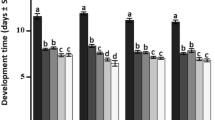Abstract
Five constant temperatures between 14 and 30°C were used to evaluate their effect on the development time and adult emergence of five Trichogramma species found parasitizing eggs of the velvetbean caterpillar Anticarsia gemmatalis Hübner (Lepidoptera: Noctuidae) on soybeans in subtropical Southern Brazil. Host eggs were parasitized at 20°C and then transferred to the study temperatures to follow development and emergence of parasitoids. All five species were able to develop and emerge within the range of temperatures evaluated, and the effect of temperature on development rates could be described by linear regression. Trichogramma acacioi Brun, Moraes & Soares and T. rojasi Nagaraja & Nagarkatti were the most cold-tolerant species, with lower threshold temperatures of 8.1 ± 0.16°C and 9.2 ± 0.16°C, respectively. Trichogramma atopovirilia Oatman & Platner was the least cold-adapted species, with a lower threshold of 10.2 ± 0.13°C. Degree-day accumulation ranged from 153.8 DD for T. atopovirilia to 190.7 DD for T. acacioi. Adult emergence was higher than 90% for T. atopovirilia and T. pretiosum at all temperatures, whereas T. lasallei Pinto emergence dropped to 71.3% at 14°C and to 58.3% at 26°C, both significantly lower than the emergence of T. pretiosum and T. atopovirilia. Significantly less T. acacioi adults emerged at 30°C than either T. pretiosum or T. atopovirilia. The sex-ratio was not affected within the range of temperatures studied, and varied from 0.65 to 0.88 (female/(male + female)). Differences among Trichogramma spp. densities in the field can be attributed to slower development rates and/or reduced emergence of adults, both at low and high temperatures.

Similar content being viewed by others
References
Avanci MRF, Foerster LA, Cañete CL (2005) Natural parasitism in eggs of Anticarsia gemmatalis Hübner (Lepidoptera: Noctuidae) by Trichogramma spp. (Hymenoptera: Trichogrammatidae) in Brazil. Revta Bras Entomol 49:148–151
Buttler GD Jr, López JD (1980) Trichogramma pretiosum: development in two hosts in relation to constant and fluctuating temperatures. Ann Entomol Soc Am 73:671–673
Campbell A, Frazer BD, Gilbert N, Gutierrez AP, Mackauer AP (1974) Temperature requirements of some aphids and their parasites. J Appl Ecol 11:431–438
Cañete CL, Foerster LA (2003) Incidência natural e biologia de Trichogramma atopovirilia Oatman & Platner, 1983 (Hymenoptera: Trichogrammatidae) em ovos de Anticarsia gemmatalis Hübner, 1818 (Lepidoptera: Noctuidae). Revta Bras Entomol 47:201–204
Chihrane J, Laugé G, Hawlitzky N (1993) Effects of high temperature shocks on the development and biology of Trichogramma brassicae (Hym.: Trichogrammatidae). Entomophaga 38:185–192
Cônsoli FL, Parra JRP (1995) Effects of constant and alternating temperatures on Trichogramma galloi Zucchi (Hym., Trichogrammatidae) biology. Development and thermal requirements. J Appl Ent 119:415–418
Foerster LA, Avanci MRF (1999) Egg parasitoids of Anticarsia gemmatalis Hübner (Lepidoptera: Noctuidae) in soybeans. An Soc Entomol Brasil 28:545–548
Garcia PV, Wajnberg E, Pizzol J, Oliveira MLM (2002) Diapause in the egg parasitoid Trichogramma cordubensis: role of temperature. J Insect Physiol 48:349–355
Greene GL, Leppla NC, Dickerson WA (1976) Velvetbean caterpillar: a rearing procedure and artificial medium. J Econ Ent 69:487–488
Grille G, Basso C (1995) Biology, thermal requirements and performance of Trichogramma pretiosum Riley and T. galloi Zucchi under laboratory conditions. In: Wajnberg E, Vinson SB (eds.) Trichogramma and other egg parasites, Les Colloques de l’INRA 73, pp 79–82
Harrison WW, King EG, Ouzts JD (1985) Development of Trichogramma exiguum and T. pretiosum at five temperature regimes. Environ Entomol 14:118–121
Hohmann CL, Luck RF (2000) Effect of temperature on the development and thermal requirements of Wolbachia-infected and antibiotically cured Trichogramma kaykai Pinto and Stouthamer (Hymenoptera: Trichogrammatidae). An Soc Entomol Brasil 29:497–505
Keller MA (1986) Overwintering by Trichogramma exiguum in North Carolina. Environ Entomol 15:659–661
Li YL (1994) Worldwide use of Trichogramma for biological control on different crops: a survey. In: Wajnberg E, Hassan SA (eds) Biological Control with egg parasitoids. CAB International, Wallingford, pp 37–53
Lopez JD, Morrison RK (1980) Overwintering of Trichogramma pretiosum in Central Texas. Environ Entomol 9:75–78
Maceda A, Hohmann CL, Santos HR (2003) Temperature effects on Trichogramma pretiosum Riley and Trichogrammatoidea annulata De Santis. Braz Archiv Biol Technol 46:27–32
Molina RMS, Fronza V, Parra JRP (2005) Seleção de Trichogramma spp. para o controle de Ecdytolopha aurantiana, com base na biologia e exigências térmicas. Revta Bras Entomol 49:152–158
Parker FD, Pinnell RE (1971) Overwintering of some Trichogramma spp. in Missouri. J Econ Ent 64:80–81
Polaszek A, Foerster LA (1997) Telenomus cyamophylax n. sp. (Hymenoptera: Scelionidae) attacking eggs of the velvetbean caterpillar, Anticarsia gemmatalis Hübner (Lepidoptera: Noctuidae). An Soc Entomol Brasil 26:177–181
Rundle BJ, Hoffmann AA (2003) Overwintering of Trichogramma funiculatum Carver (Hymenoptera: Trichogrammatidae) under semi-natural conditions. Environ Ent 32:290–298
Smith SM (1996) Biological control with Trichogramma: advances, successes, and potential of their use. Ann Rev Ent 41:375–406
Acknowledgments
This research was carried out with scholarships provided by the Brazilian National Research Council (CNPq) and Brazilian Federal Agency for Support and Evaluation of Graduate Education (CAPES). The authors are grateful to Dr. John Pinto of University of California, Riverside, USA, Dr. Roberto A. Zucchi of Universidade de São Paulo, Dr. Ranyse B. Q. da Silva of Empresa Brasileira de Pesquisa Agropecuária, Embrapa Roraima for the identification of the Trichogramma species, and to Dr. Robert M. Perrin, formerly at Syngenta, Jealott’s Hill International Research Centre for the critical revision of the manuscript.
Author information
Authors and Affiliations
Corresponding author
Additional information
Handling Editor: Dirk Babendreier.
Rights and permissions
About this article
Cite this article
Foerster, M.R., Foerster, L.A. Effects of temperature on the immature development and emergence of five species of Trichogramma . BioControl 54, 445–450 (2009). https://doi.org/10.1007/s10526-008-9195-4
Received:
Accepted:
Published:
Issue Date:
DOI: https://doi.org/10.1007/s10526-008-9195-4




